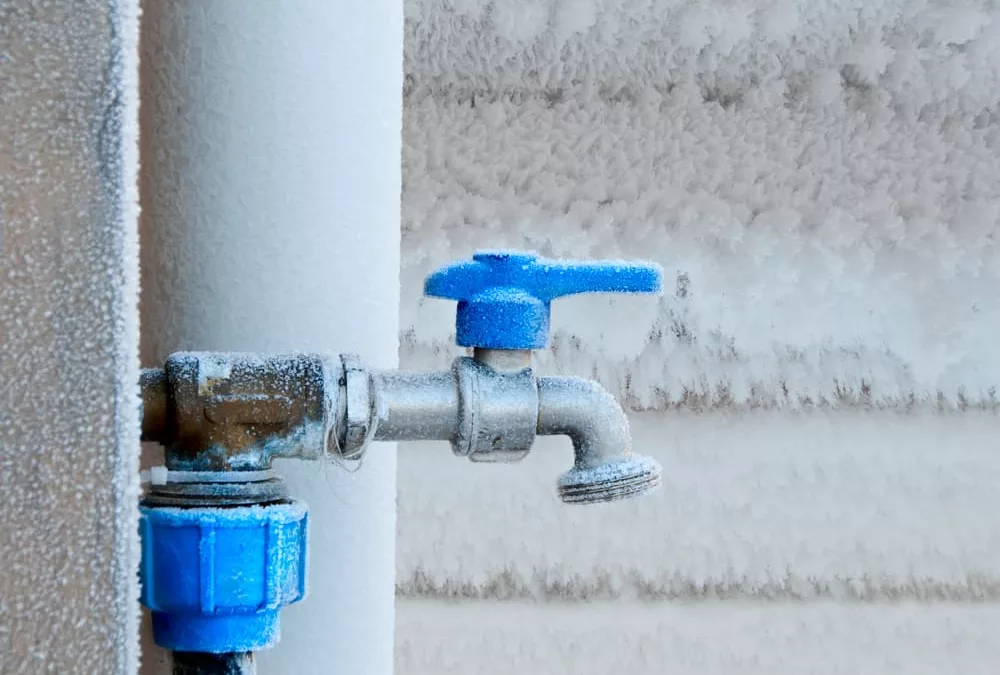As the winter season approaches, it’s important for homeowners to take proactive measures to protect their sewer pipes from freezing. Freezing sewer pipes can lead to a host of problems, from unpleasant odors to costly repairs. Let’s discuss the steps you can take to prevent frozen sewer pipes and ensure the efficient functioning of your plumbing system throughout the winter months.
Understanding the Risks of Frozen Sewer Pipes
Freezing temperatures pose a significant risk to your sewer pipes. When the temperature drops below freezing, the water inside the pipes can freeze and expand, leading to cracks or even burst pipes. Moreover, frozen sewer pipes can cause blockages, resulting in backups and potential sewage leaks in your home. It’s crucial to address these issues promptly to prevent further damage and costly repairs.
1. Insulating Pipes in Winter: A Proactive Approach
Taking proactive steps to insulate your pipes before the onset of winter is the best way to prevent freezing. By insulating your pipes, you can protect them from extreme temperatures and minimize the risk of freezing. Here are some effective methods to insulate your sewer pipes:
2. Pipe Insulation Sleeve
One of the most common and effective methods of insulating pipes is by using pipe insulation sleeves. These sleeves are made of foam or fiberglass and fit snugly around the pipes, providing a protective barrier against freezing temperatures. Pipe insulation sleeves are affordable, easy to install, and readily available at hardware stores.
3. Heat Tape
Heat tape, also known as heat cable, is another useful tool for preventing frozen sewer pipes. It is an electrical heating element that can be wrapped around the pipes to provide consistent heat and prevent freezing. Heat tape is particularly effective for exposed pipes or those located in unheated areas such as basements or crawl spaces.
4. Insulating Foam
Insulating foam is another option for protecting your sewer pipes from freezing. It comes in the form of pre-cut foam tubes that can be easily fitted around the pipes. Insulating foam provides an additional layer of protection and helps maintain a stable temperature inside the pipes.
5. Heating Pads
For extreme cold conditions or areas prone to frequent freezing, using heating pads can be beneficial. Heating pads are designed to provide a consistent source of heat to the pipes, ensuring that the water inside remains above freezing temperature. These pads can be controlled with a thermostat to regulate the heat output.

Identifying Vulnerable Areas: Where to Focus Your Attention
While insulating your pipes is crucial, it’s equally important to identify the vulnerable areas where freezing is most likely to occur. By focusing on these areas, you can allocate your resources effectively and minimize the risk of frozen sewer pipes. Here are some common vulnerable areas to consider:
1. Exposed Pipes
Exposed pipes, such as those located outside or in unheated areas, are highly susceptible to freezing. Pay close attention to any pipes that are not insulated or adequately protected. Use insulation sleeves, heat tape, or other methods mentioned earlier to safeguard these exposed pipes.
2. Pipes in Crawl Spaces and Basements
Crawl spaces and basements are notorious for their low temperatures, making them vulnerable to frozen pipes. Insulate the pipes in these areas using foam insulation or heating pads to maintain a stable temperature and prevent freezing.
3. Outdoor Faucets and Hose Bibs
Outdoor faucets and hose bibs are commonly overlooked when it comes to winterizing plumbing systems. These fixtures are especially prone to freezing due to their exposure to the elements. Disconnect and drain any hoses connected to outdoor faucets, and install freeze-proof faucet covers to protect them from freezing temperatures.
4. Pipes Near Exterior Walls
Pipes located near exterior walls are at a higher risk of freezing because they are exposed to cold air. Insulate these pipes using insulation sleeves or foam to create a protective barrier against freezing temperatures.
Maintaining Proper Heat and Airflow
In addition to insulation, maintaining proper heat and airflow in your home can help prevent frozen sewer pipes. By following these simple steps, you can ensure that your plumbing system stays functional throughout the winter:
Keep Thermostats Set Above Freezing
Maintain a consistent temperature in your home by keeping thermostats set above freezing, even when you are away. This will help prevent the temperature inside the house from dropping to a level that can freeze the pipes.
Open Cabinet Doors
If you have pipes located inside cabinets or vanities, open the doors to allow warm air to circulate around them. This will help maintain a higher temperature and prevent freezing.
Seal Drafts and Insulate Walls
Seal any drafts around windows, doors, and other openings to prevent cold air from entering your home. Additionally, insulate exterior walls to keep the temperature inside more stable and minimize the risk of frozen pipes.
Signs of Frozen Sewer Pipes
Despite your best efforts, freezing can still occur. It’s important to be aware of the signs of frozen sewer pipes so that you can take immediate action. Here are some common indicators of frozen pipes:
- No water or reduced water flow from faucets or fixtures
- Unusual gurgling or bubbling sounds coming from drains
- Foul odors or sewage smells coming from drains or toilets
- Visible frost on exposed pipes
- Wet or damp areas around pipes or on walls
If you notice any of these signs, it’s crucial to act quickly to prevent further damage.
Thawing Frozen Sewer Pipes
Thawing frozen sewer pipes is a delicate process that requires caution to avoid causing additional damage. Here are some steps you can take to safely thaw frozen pipes:
- Open Faucets and Drains
Open the faucets connected to the frozen pipes to relieve any pressure and allow water to flow once the pipes start thawing. Additionally, open any nearby drains to provide an exit for the water as it begins to melt. - Apply Heat to the Frozen Pipes
Apply gentle heat to the frozen pipes using a hairdryer, heat lamp, or electric heating pad. Start from the end nearest to the faucet and work your way towards the frozen section. Never use an open flame or high-temperature heat sources, as they can damage the pipes. - Use Warm Towels or Hot Water Bottles
Wrap warm towels or place hot water bottles around the frozen pipes to provide additional heat. This can help speed up the thawing process and prevent re-freezing. - Call a Professional Plumber
If you are unable to thaw the frozen pipes or if you suspect any damage, it’s best to call a professional plumber. They have the expertise and specialized tools to safely thaw the pipes and address any underlying issues.
Additional Tips for Winter Sewer Pipe Care
To further ensure the efficient functioning of your sewer pipes during winter, consider implementing the following tips:
- Schedule a Professional Inspection: Before the winter season, have a professional plumber inspect your sewer pipes for any existing issues or potential vulnerabilities. They can identify problem areas and provide recommendations for preventive measures.
- Keep a Drip of Water: In extremely cold temperatures, allowing a small trickle of water to flow through faucets can help prevent freezing. Moving water is less likely to freeze than stagnant water.
- Disconnect and Drain Outdoor Hoses: Disconnect and drain any outdoor hoses to prevent water from freezing inside them and backing up into the pipes.
- Know the Location of Shut-Off Valves: Familiarize yourself with the location of shut-off valves in case of emergencies. If a pipe does burst, shutting off the water supply can help minimize damage.
- Educate Family Members: Teach your family members about the importance of not pouring hot liquids down drains during freezing temperatures. Hot water can cause rapid cooling and increase the risk of freezing.
- Monitor Your Sewer System: Regularly inspect your sewer system for any signs of leaks, blockages, or unusual odors. Promptly addressing any issues can prevent further damage and costly repairs.
Monitor Your Sewer System: Regularly inspect your sewer system for any signs of leaks, blockages, or unusual odors. Promptly addressing any issues can prevent further damage and costly repairs.
If you require any assistance or have concerns about your sewer pipes or plumbing system, don’t hesitate to reach out to NW Sewer and Drain, your trusted sewer and drain specialist serving the greater Seattle area. Our team of experienced professionals is here to provide expert advice and reliable solutions to all your plumbing needs. Stay warm and worry-free this winter with NW Sewer and Drain by your side.
FAQ: Winter Sewer Pipe Protection
1. What are the risks of freezing sewer pipes during winter?
Freezing temperatures pose a significant risk to sewer pipes, leading to cracks, burst pipes, blockages, and potential sewage leaks. Addressing these issues promptly is crucial to prevent further damage and costly repairs.
2. How can homeowners prevent frozen sewer pipes?
Homeowners can prevent frozen sewer pipes by insulating their pipes using methods such as pipe insulation sleeves, heat tape, insulating foam, and heating pads. Identifying vulnerable areas and maintaining proper heat and airflow in the home are also essential preventive measures.
3. What are the common signs of frozen sewer pipes?
Common signs of frozen sewer pipes include reduced water flow from faucets, gurgling or bubbling sounds from drains, foul odors, visible frost on pipes, and wet areas around pipes or walls. Recognizing these signs allows homeowners to take immediate action.
4. How can homeowners safely thaw frozen sewer pipes?
Homeowners can safely thaw frozen sewer pipes by opening faucets and drains, applying gentle heat using a hairdryer or heating pad, and using warm towels or hot water bottles. If unable to thaw the pipes or suspect damage, calling a professional plumber is recommended.
5. What additional tips can homeowners follow for winter sewer pipe care?
Additional tips for winter sewer pipe care include scheduling a professional inspection before winter, keeping a drip of water flowing through faucets, disconnecting and draining outdoor hoses, knowing the location of shut-off valves, educating family members, and regularly monitoring the sewer system for leaks or blockages.
6. Why is it important to insulate sewer pipes before winter?
Insulating sewer pipes before winter is important to protect them from freezing temperatures. Proper insulation helps maintain a stable temperature inside the pipes, preventing freezing, cracks, and burst pipes, thus avoiding costly repairs and inconveniences.
7. What are the benefits of using heat tape for sewer pipe insulation?
Heat tape, also known as heat cable, is beneficial for sewer pipe insulation as it provides consistent heat to prevent freezing. It is particularly effective for exposed pipes or those in unheated areas, helping homeowners avoid the risks associated with frozen pipes.
8. How can homeowners identify vulnerable areas for freezing sewer pipes?
Homeowners can identify vulnerable areas for freezing sewer pipes by focusing on exposed pipes, pipes in crawl spaces and basements, outdoor faucets and hose bibs, and pipes near exterior walls. Insulating these areas effectively minimizes the risk of freezing.
9. Why should homeowners monitor their sewer system during winter?
Monitoring the sewer system during winter is crucial to detect any signs of leaks, blockages, or unusual odors promptly. Addressing these issues early prevents further damage and ensures the efficient functioning of the plumbing system throughout the season.
10. Why choose NW Sewer and Drain for winter sewer pipe care?
Homeowners can trust NW Sewer and Drain for winter sewer pipe care due to our experienced professionals and reliable solutions. Serving the greater Seattle area, we offer expert advice and top-notch services to ensure worry-free plumbing during winter.



